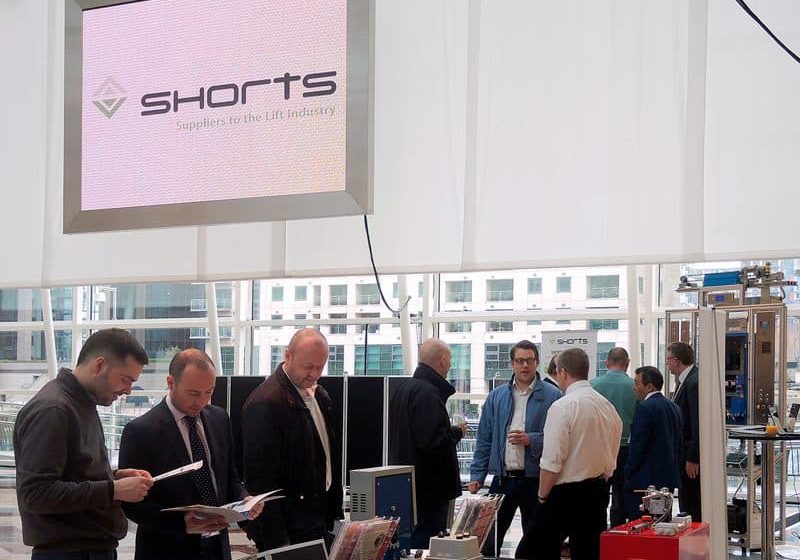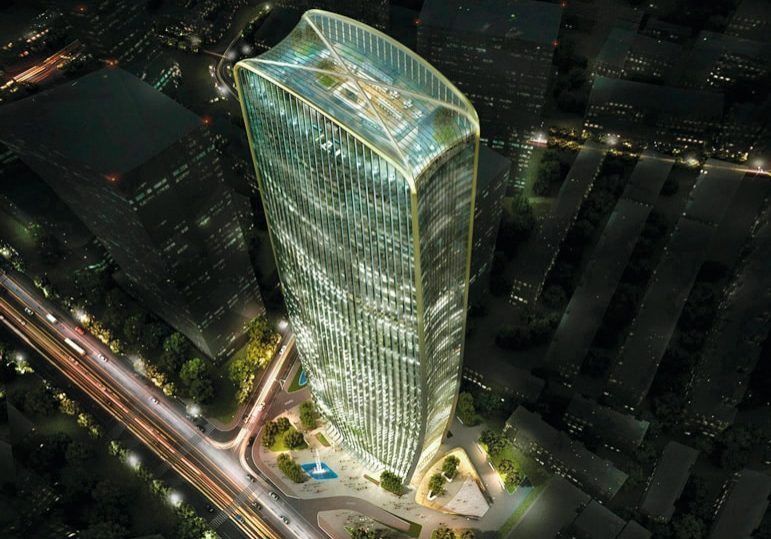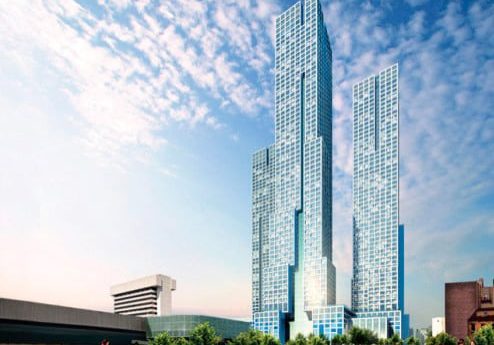A Beacon of Light at the Gate of the Black Forest
Jun 1, 2014
ThyssenKrupp Elevator elevates R&D, ensures global footprint, promotes tourism with Rottweil, Germany, test tower.
Elevator test towers are usually tall concrete buildings, technically useful but not very visually exciting. Not so for a huge project ThyssenKrupp Elevator AG unveiled on April 11, 2014, in Rottweil, Germany. The small, lovely town of Rottweil, the oldest in Bade-Württemberg, has been known since the Middle Ages as the “city of towers.” The ThyssenKrupp Elevator project, which was enthusiastically welcomed by Rottweil Mayor Ralf Bross and residents, will definitely help the name stick. At 244 m, it will be the second-tallest structure in Germany, after the Berlin TV Tower.
The beauty of the test tower, expected to be completed in the next three years, is that it is an architect’s dream and will boast the tallest observation platform in Germany. Bross, who understands what the flagship structure means to southern Germany, states:
“The test tower will open a new chapter in the history of Rottweil’s architecture. The interplay between the medieval city center and the new test tower is a unique selling point with which our city silhouette will stand out from all comparable cities, and will provide a significant boost to tourism and the local economy.”
The man hired for the project is the famous German-American architect Helmut Jahn, based in Chicago and well known for such designs as the US$800-million Sony Center on the Potsdamer Platz, Berlin; the MesseTurm in Frankfurt, Germany; One Liberty Place, formerly the tallest building in Philadelphia; and Suvarnabhumi Airport in Bangkok. He conceived the test tower with his colleague, architect and structural engineer Werner Sobek, known for his environmentally sustainable and self-sufficient houses that use a polyurethane skin on a carbon-fiber frame.
Jahn said the ThyssenKrupp Elevator project blends form and function, noting:
“Art and architecture are very close. The boundaries between the two are very hazy. In the case of the Rottweil test tower, one needs to know history but not to repeat history. This tower is an opportunity to take the city into the future and turn this technical building into an artistic statement. The ‘tower of light’ will represent the company and will be a unique experience for the public, a new chapter in the 2,000-year history of Rottweil, ‘city of towers.’”
Iconic buildings often start by being rejected by the public. It was the case for the Eiffel Tower in Paris at the end of the 19th century and for the Washington Monument in the mid 19th century. Not so in this case. The building is so artistic that it promises to become another hallmark of Rottweil. The ThyssenKrupp Elevator test tower will be enveloped by a fabric in the form of a spiral that will create a relationship with the environment and assume different appearances, depending on the light and time of day or night. The tower will be luminescent; it will be lit from within, under a transparent envelope. The glass-fiber fabric of the envelope will be woven in such a way that it will be more transparent toward the top, where the concrete structure will be partly visible, and give the impression of vanishing in the sky under daylight.
A Test Tower to Foster Future Innovations
The 244-m-tall tower represents an investment of more than US$40 million. It will contain 15 test shafts, and its height will make it possible to test high-speed elevators up to 18 mps. Such units need longer acceleration and deceleration phases. Its height is designed to test double-deck elevators, as well as conventional ones. ThyssenKrupp Elevator wants to use the tower to not only develop new technologies, but also to test and certify its products.
The tower will be accessible to the 10,000 engineering students in the region, home to several respected universities and engineering schools, not only in Stuttgart and Konstanz, Germany, but also in St. Gallen, Winterthur and Zürich, Switzerland. It is an ideal recruiting base for ThyssenKrupp Elevator.
The location was not chosen at random. On the contrary, Bade-Württemberg is the heartland of ThyssenKrupp Elevator, which has its main plant at Neuhausen, close to Stuttgart. That facility produces some 400 high-rise elevators and special systems per year, along with more conventional types of elevators. Close by is also the Pliezhausen R&D center. The three locations will work together, and employees will be added to the existing 1,500 ThyssenKrupp Elevator employees in the region. The company capitalizes on the “made in Germany” image, which is, and remains, a plus around the world. With a portfolio that includes outfitting the tallest building in the U.S. – the 541-m-tall One World Trade Center in New York City – with 73 elevators that serve 104 floors at 10 mps, ThyssenKrupp Elevator has reinforced its position as a world leader in servicing the highest buildings and developing the fastest applications.
High Rises for a Better Urbanized World
Andreas Schierenbeck, chairman of the ThyssenKrupp Elevator Executive Board, smiled as he unveiled the test tower, which merges cutting-edge technology and green engineering. Illustrating the need for such a structure, Schierenbeck said:
“Urbanization is an unstoppable trend. The urban and commercial floor space will have to grow by 85% by 2025 to meet the migration of populations to conurbations of more than 10 million inhabitants. [1] The most viable construction options are mid- to high-rise buildings, which means that the global demand for elevator equipment and services is projected to rise over 5% annually to EUR52 billion (US$2.76 billion).”
Meeting demands will indeed be a challenge for the construction industry. Adds Schierenbeck:
“With the new test tower, we are poised for success in the promising elevator market for mid- and high-rise buildings. Our new elevator technology enables the reduction of the elevator-escalator footprint in a building, releasing significant areas for additional rent revenues.”
In the next 10 years, large conurbations of more than 10 million inhabitants in emerging economies will account for 50% of the world’s population. The urban population of the world will increase to 2.8 billion people by 2050, and 2.62 billion of that number will be in emerging markets. In North America and Europe, the largest urban areas are growing faster than other cities. Cities of more than one million people in the U.S. grow at 3.2%, faster than the 2.4% average U.S. growth rate. At the same time, cities of less than 500,000 people grow an average of 0.2%, and the smaller towns see their population decline.[1]
In the emerging world, cities such as Shanghai; Saõ Paulo, Brazil; Istanbul; and Lagos, Nigeria; are examples of relatively new megacities of more than 10 million inhabitants, which are redefining the urban landscape. By 2020, China will lead the way, with 121 urban conglomerations (populations of more than 1 million), followed by India with 58 and the U.S. with 46. The countries with the swiftest growth rates are in South and Southeast Asia, the Middle East, Central America, and Sub-Saharan Africa.[1]
The 21st century will be the metropolitan century
Of course, this fast development puts pressure on urban planners and infrastructure developers. Efficient urban planning is not always present, and the economies of scale to be expected from urbanization are not always reached, at least not early in the process. Restrictive regulations, such as the cap on building heights in Mumbai, can prove to be a severe hindrance to progress, estimates ThyssenKrupp Elevator. After the 2008 slump, the construction industry has shown an obvious upswing in catering to demands from new urban populations. Building materials is clearly one of the key sectors earmarked for investment to capitalize on the urbanization boom.[2]
All this means that the list of the world’s tallest buildings will increase in coming years. Currently, more than 180 buildings under construction will rise above 250 m, 50 of which should be completed every year. Architects are thinking very seriously about “mile-high buildings” (ELEVATOR WORLD, April 2014). Not surprisingly, the majority of new high rises are in emerging markets, such as Guangzhou and Beijing in China, and Saõ Paulo.
ThyssenKrupp Elevator stresses that, astonishingly, the elevator/escalator footprint in a building occupies 25-50% of its floor space. Technologies such as its TWIN elevators can reduce floor space occupied by elevators by up to 30%. Increases in speed and technology, improved traffic management, and multiple cars in the same shafts also contribute to an increased interest in building higher in the future world’s megacities. The future Rottweil test tower, for which a building permit is expected after summer 2014, is a key building block in ThyssenKrupp’s global approach.
References
[1] Richard Dobbs, Jaana Remes, James Manyika, Charles Roxburgh, Sven Smit and Fabian Schaer. “Urban World: Cities and the Rise of the Consuming Class,” McKinsey Global Institute report, June 2012.
[2] “Emerging Consumer Survey 2012,” Credit Suisse Emerging Market Research Institute, January 2012.
Get more of Elevator World. Sign up for our free e-newsletter.









